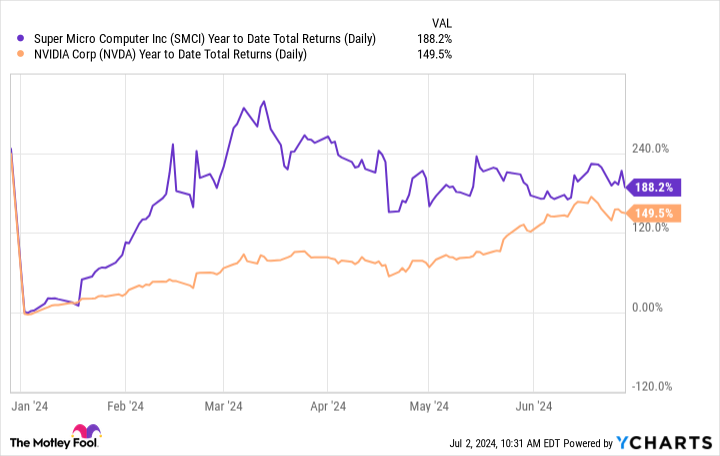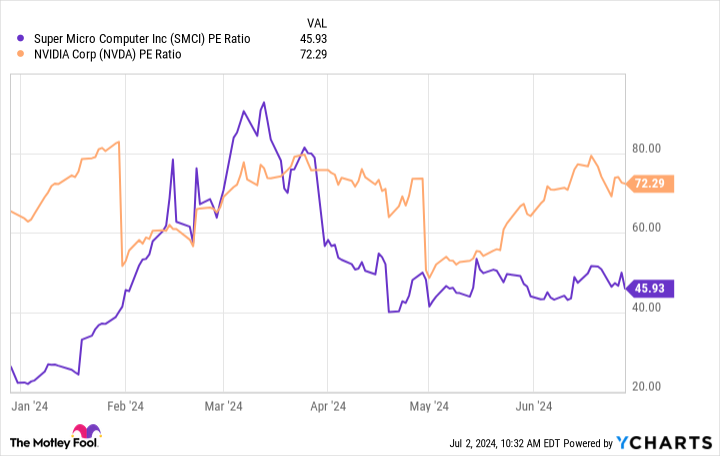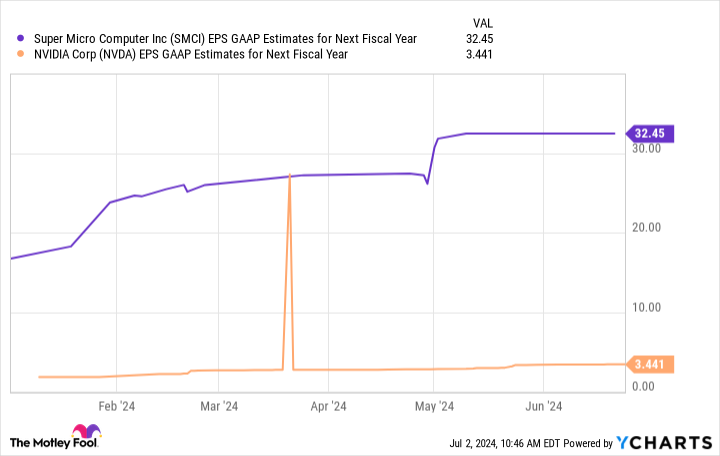The artificial intelligence (AI) revolution is in full swing, and the big winner of that revolution is Nvidia (NASDAQ: NVDA).
Well, maybe it’s the second-biggest.
Nvidia is no doubt the most-in-focus company in the world right now. Its GPUs are in hyper-demand as companies race to deploy AI. Certainly, Nvidia has been the biggest winner of the popular “Magnificent Seven” stocks.
However, one AI beneficiary actually outpaced Nvidia in the first half to lead the entire S&P 500 index.
Super Micro Computer rides Nvidia’s coattails to lead the market
The best-performing stock in the S&P 500 in the first half of the year wasn’t Nvidia, but rather Super Micro Computer (NASDAQ: SMCI). Supermicro returned a whopping 188% in the first half of the year, versus just 150% for Nvidia, dividends included. Not only that, but while Nvidia ended the quarter near year-to-date highs, Supermicro was actually significantly higher earlier in the half, reaching a year-to-date gain as large as 331% at one point in mid-March!

How did Supermicro pull it off? It’s actually for the same reasons Nvidia continued to take off: torrid artificial intelligence-related growth. Actually, one could say Supermicro, as a server-maker, rode a growth wave on Nvidia’s back, as demand for Supermicro’s AI servers, which make up over 50% of its revenue and mostly contain Nvidia GPUs, took off. So Supermicro’s AI-fueled growth was likely due to essentially reselling Nvidia chips, with a small markup, indicated by Supermicro’s relatively low 15.5% gross margins last quarter.
Nvidia also actually posted higher revenue growth than Supermicro, at 262% growth in Q2, versus “just” 200% growth for Super Micro Computer last quarter.
However, the stock market isn’t always exactly correlated with financial results, as we’ve seen. So, now did Supermicro’s stock manage to pull off such a feat?


Starting from a lower valuation
While business performance over the long term is the key determinant of long-term performance, valuation also matters, especially in the short-term. And as we can see, Supermicro was starting from a much lower valuation this year.
On Jan. 1, Supermicro traded around 25 times earnings, while Nvidia traded at 65 times earnings. Yet during the quarter, Supermicro’s valuation expanded to around 45 times earnings — an 80% increase — while Nvidia’s P/E ratio expanded to 72 — a mere 8% increase.


Meanwhile, both companies saw their future earnings estimates rise, and by roughly the same amount through the first half, with each stock seeing its forward earnings estimates from Wall Street analysts one year out increasing by about 80% to 90%.
Story continues


The earnings estimate increases were driven by stellar earnings and expectations from both companies during the quarter. Supermicro’s estimates got a big boost early in the year when it greatly increased its forward guidance on its February earnings call. And while earnings estimates continued to rise even after its May 1 earnings report, the stock sold off. This was perhaps due to the prior quarter setting such a high bar of expectations.
Meanwhile, Nvidia continued to rise as torrid growth posted in both February and May continued to defy the skeptics. However, as the company was already suffering from high expectations coming into the year, it didn’t rally quite as much after its February earnings, leaving “room” to surprise after its May earnings.
Thus, the outperformance from Supermicro largely comes down to starting expectations.
Valuation matters
Trying to parse any lesson here is really splitting hairs, as both stocks have outperformed handily, and for the same reasons. However, one lesson to draw is that valuation matters. If a company is a great company but already trades at a high valuation, it may not rise as much as a company that might not be quite as good, but is able to outperform starting expectations by a greater degree.
Think of it like a point spread in football. Market valuations are essentially “point spreads” on stocks. You only win a bet if your team wins the game and beats the point spread. Similarly, if your team loses but by less than others think, you still win the bet.
One of the greatest growth investors of all time, Phil Fisher, once said, “Every significant price move of any individual common stock in relation to stocks as a whole occurs because of a changed appraisal of that stock by the financial community.”
As AI enthusiasm takes hold and many tech stocks climb to very high valuations, this is something to keep in mind as expectations seem to have gone higher and higher for AI winners this year.
Should you invest $1,000 in Super Micro Computer right now?
Before you buy stock in Super Micro Computer, consider this:
The Motley Fool Stock Advisor analyst team just identified what they believe are the 10 best stocks for investors to buy now… and Super Micro Computer wasn’t one of them. The 10 stocks that made the cut could produce monster returns in the coming years.
Consider when Nvidia made this list on April 15, 2005… if you invested $1,000 at the time of our recommendation, you’d have $761,658!*
Stock Advisor provides investors with an easy-to-follow blueprint for success, including guidance on building a portfolio, regular updates from analysts, and two new stock picks each month. The Stock Advisor service has more than quadrupled the return of S&P 500 since 2002*.
See the 10 stocks »
*Stock Advisor returns as of July 2, 2024
Billy Duberstein and/or his clients positions in Super Micro Computer and has the following options: short January 2025 $1,840 calls on Super Micro Computer, short January 2025 $110 puts on Super Micro Computer, short January 2025 $125 puts on Super Micro Computer, short January 2025 $130 puts on Super Micro Computer, short January 2025 $280 calls on Super Micro Computer, and short January 2025 $85 puts on Super Micro Computer. The Motley Fool has positions in and recommends Nvidia. The Motley Fool has a disclosure policy.
How This Chip Company Outperformed Nvidia in the First Half was originally published by The Motley Fool
